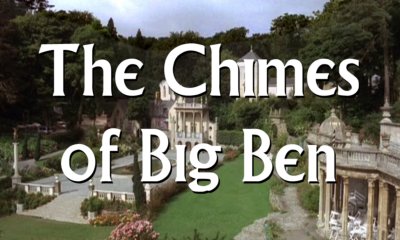
The Prisoner Episode by Episode
E02 The Chimes of Big Ben
6 October 1967
Written by Vincent Tilsley
Directed by Don Chaffey
Story: Number Six helps the newly arrived Number Eight adjust to village life, and she in turn helps him in an escape attempt…
Who is Number Two? Leo McKern
Guest Cast: Nadia Grey, Finlay Currie, Christopher Benjamin, Richard Wattis, Kevin Stoney
Information: There has been a long-raging debate about the ideal viewing order for the episodes of The Prisoner. As with most 1960s television, the show’s episodes were not broadcast in the same order they were produced (broadcast second, The Chimes of Big Ben was the fifth instalment made). Additionally, most 1960s action-adventure series—whether British or American (and ITC’s shows were clearly targeted at the American market while made in the UK)—didn’t bother much with episode-to-episode continuity. Most episodes concluded with a status quo reset, and so could be viewed in any order. That doesn’t work with The Prisoner, but neither does viewing the episodes in transmission order [which this blog is sticking with, as we’re marking the 50th anniversary of each episode’s transmission].
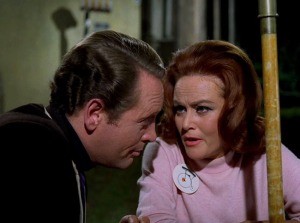 Clearly, Arrival is the first episode. Equally obviously, the final three instalments need to be viewed at the end. In between there have been various takes on what order the episodes should run, using clues from internal continuity, the history of the series production, and the originally planned broadcast order by Patrick McGoohan (which ITV did not follow). For example, given that The Chimes of Big Ben sees Number Six fairly settled in The Village, to the extent that he seems happy to show the newly-arrived Number Eight the ropes, suggests that the episode should fall further back in the run than in second place. None of it matters greatly to the enjoyment of the individual episodes or the series as a whole, but if you are determined to discover alternative viewing orders, a little online research provides various competing guides.
Clearly, Arrival is the first episode. Equally obviously, the final three instalments need to be viewed at the end. In between there have been various takes on what order the episodes should run, using clues from internal continuity, the history of the series production, and the originally planned broadcast order by Patrick McGoohan (which ITV did not follow). For example, given that The Chimes of Big Ben sees Number Six fairly settled in The Village, to the extent that he seems happy to show the newly-arrived Number Eight the ropes, suggests that the episode should fall further back in the run than in second place. None of it matters greatly to the enjoyment of the individual episodes or the series as a whole, but if you are determined to discover alternative viewing orders, a little online research provides various competing guides.
At the time this episode was made, Patrick McGoohan probably had little idea of how he might conclude the series, so any suggestion that this episode should be viewed second due to the presence of Leo McKern as the new Number Two is probably incorrect. McKern returned for the final two episodes, thus providing some much needed continuity with the show’s earliest episodes, a choice that McGoohan must’ve made only in hindsight when faced with the need to wrap things up.
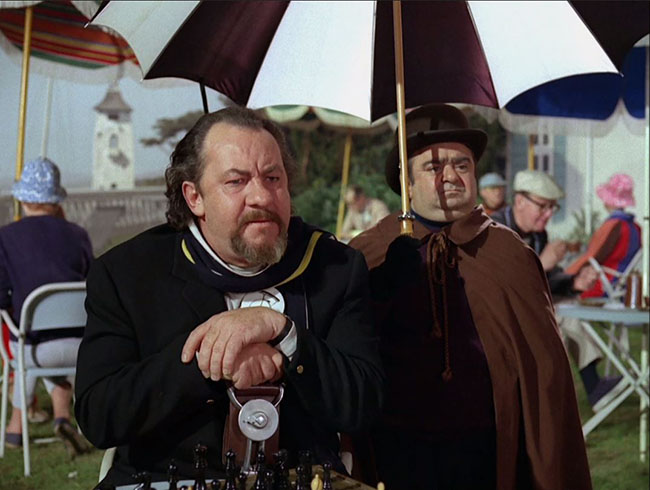
McKern makes quite an impression here, with his Number Two seemingly solely obsessed with breaking Number Six. He believes that if he can get the answer to the reason behind Number Six’s mysterious resignation then he’ll be able to ensure that his captive would talk willingly about any other secrets he might know. He seems to be energised by his interchanges with Number Six, viewing his captive’s presence as something of a challenge to his abilities to ensure co-operation from his charges.
Number Two effectively manipulates Number Six into the position of mentor to Number Eight, who like him (in the previous episode) is disorientated by her involuntary relocation to The Village. She is of Eastern European extraction and appears to have resigned from a job of some importance and sensitivity, just as Number Six did. A champion swimmer, she first attempts to swim away from the village. Her later suicide attempt engages the sympathy of Number Six, who agrees to participate in Number Two’s Arts and Crafts Competition if his captor will leave Number Eight alone. Of course, he has an ulterior motive, and his abstract sculpture (the only entry in the competition that does not pay homage to Number Two) can be recombined as a boat in which he and Number Eight later attempt their escape.
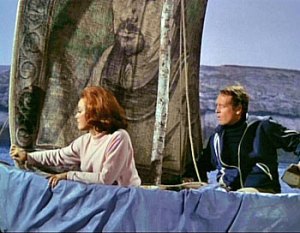 The escape involves an elaborate trip in Number Six’s manufactured boat, followed by a journey by sea and plane for both Number Six and Number Eight locked in a wooden crate. Their seemingly arrival in London, welcomed by the titular chimes of Big Ben, sees Number Six reunited with his former bosses. However, a borrowed watch tips off Number Six to the elaborate charade he’s been caught up in—the episode highlight moment comes when he opens the door of the London office to discover himself back in The Village. McGoohan’s weary acceptance of the inevitability of the deception would seem to suggest that this episode would be better placed fifth or so in the running order following several other thwarted escape attempts. That sort of viewing order would give Number Six’s seeming initial success much more impact, and so heighten the disappointment of his return to The Village.
The escape involves an elaborate trip in Number Six’s manufactured boat, followed by a journey by sea and plane for both Number Six and Number Eight locked in a wooden crate. Their seemingly arrival in London, welcomed by the titular chimes of Big Ben, sees Number Six reunited with his former bosses. However, a borrowed watch tips off Number Six to the elaborate charade he’s been caught up in—the episode highlight moment comes when he opens the door of the London office to discover himself back in The Village. McGoohan’s weary acceptance of the inevitability of the deception would seem to suggest that this episode would be better placed fifth or so in the running order following several other thwarted escape attempts. That sort of viewing order would give Number Six’s seeming initial success much more impact, and so heighten the disappointment of his return to The Village.
The Portmeirion scenes for The Chimes of Big Ben were shot at the end of September 1966 with studio work taking place at MGM in Borehamwood in late November 1966. Much of the studio work involved shooting on recreations of key Portmeirion buildings and locations, scenes that can be easily discerned as studio work in the finished episode (the beach location, for example, and the forested area in which Number Six constructs his work of abstract conceptual art).
The script for this sophomore outing was by Vincent Tilsley. Born in 1932, he’d been writing for television since the 1950s but wasn’t one of the regular ITC screenwriters (something McGoohan and Markstein seemed to be going for in episode writers). He’d most recently written for the BBC’s Z-Cars and would go on to script a second instalment of The Prisoner (the offbeat Do Not Forsake Me, Oh My Darling) and for many more series through the early-1970s including The Mind of Mr J. G. Reeder, The Guardians, and Mystery and Imagination. He quit television writing after his 1973 series The Death of Adolph Hitler, for ITV’s Sundy Night Theatre, was cut from a planned six hours to just two. He took up a new career as a psychotherapist, and died in September 2013 aged 81.
Director Don Chaffey (born in 1917) had worked with McGoohan on his previous series Danger Man, helming 15 episodes. Before The Prisoner he directed the Ray Harryhausen fantasy Jason and the Argonauts (1963) and the Hammer prehistory movie One Million Years B.C. (1966), starring a fur bikini clad Raquel Welch. Chaffey had set much of the visual style and tone of the series with Arrival, and he directed two further instalments in addition to The Chimes of Big Ben: Dance of the Dead and Checkmate. He went on to direct a myriad of television series including The Avengers and The Protectors, later moving to such American shows as Charlie’s Angels, Fantasy Island, T.J. Hooker (starring William Shatner), and the 1989 revival of Mission: Impossible. He died in New Zealand in November 1990, aged 73.
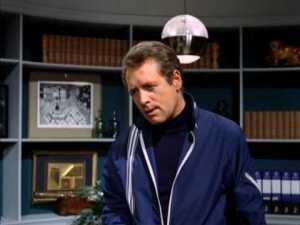 What’s it All Mean? The discussion between Number Six and Number Two at a table near the beach hints at the underlying philosophy of the series (and perhaps reflects McGoohan’s view of the world). Number Two describes The Village as ‘a perfect blueprint for world order. When the sides facing each other suddenly realise they are looking into a mirror, they will realise that this is the pattern of the future.’
What’s it All Mean? The discussion between Number Six and Number Two at a table near the beach hints at the underlying philosophy of the series (and perhaps reflects McGoohan’s view of the world). Number Two describes The Village as ‘a perfect blueprint for world order. When the sides facing each other suddenly realise they are looking into a mirror, they will realise that this is the pattern of the future.’
There is another connection that might suggest that Number Six is indeed John Drake from Danger Man—although the character’s name is different, Richard Wattis (here playing Fotheringay, apparently Number Six’s friend and boss) played Drake’s boss in the original 30-minute episodes of Danger Man.
McGoohan also reveals something of his view of both modern art and dictatorships in the Village’s Arts and Crafts Competition. As in most dictatorships, the only officially sanctioned art is that which pays homage to the dictator, hence all the citizen artworks that lovingly depict Leo McKern’s Number Two. Number Six goes in a different direction, creating a work of art entitled ‘Escape’ which doubles up as the very boat in which he and Number Eight attempt their escape. Of his abstract creation, Number Six simpy says ‘It means what it is’.
Questions of reality and trust are explored in The Chimes of Big Ben. The fake journey and London office seem to effectively fool Number Six, so convincingly has the whole thing been created that he seems taken in by it all until the out-of-time chimes give the game away. In terms of trust, Number Six maintains a wary relationship with Number Two (although he too seems to enjoy their verbal sparring matches), yet he does seem to evince some sympathy—at least initially—with Number Eight, whom he sees as undergoing the same disorienting experience he did when he first arrived in The Village. Despite the intentions of the original script, McGoohan’s own personality would not allow the depiction of a full-on love affair between the two (a similar problem had plagued Danger Man and lost McGoohan the role of James Bond).
Fist Fight: None
Alternative Versions: As with Arrival, there exists a rough cut early edit of The Chimes of Big Ben with several notable differences from the final version. The original Wilfred Josephs’ theme tune is featured, as is much of his incidental music. There’s a bit more of Rover in the rough cut than in the final episode, and one entirely omitted scene sees Number Six attempt to discern the geographical location of The Village by studying the stars. Number Six’s previous relationship with Fotheringay (they were ‘at school together’) is seeded early in this cut, but absent from the final edit. The end credits are also slightly different from those eventually adopted for the series.
Trivia: The courtyard set that includes the Exhibition Hall where the art exhibition takes place was repurposed from the film The Dirty Dozen (1967, directed by Robert Aldrich). The interior of the exhibition hall was another redressed version of the versatile Control Room/Number Two’s office set seen in Arrival.
Verdict: A classic tale of thwarted escape, The Chimes of Big Ben is a fan favourite and one of the series’ finest instalments.
Score (Out of Six): Five
Brian J. Robb
